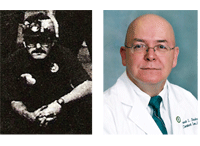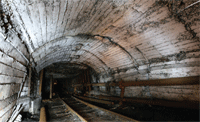I spent the first 10 years of my working life, like my father and grandfather before me, toiling away in the bowels of the earth.

Then and now: Ernie Bowling, coal miner and Dr. Ernie Bowling, optometrist.
I started my career like every mining rookie. I was required to wear a shiny red hard hat for the first six months underground, as if the hardcore veterans needed any reminder that I was as green as grass. I wasn’t placed at the face—the area of the mine where the coal is actually extracted—but was relegated to the background to do the scut work: delivering supplies to the working sections, wading up to my neck in muddy water to ensure the pumps were working, or shoveling. Endlessly shoveling ton upon ton of coal back onto the belt line.
I began to think of the shovel as an extension of my arm. I was an athlete in high school, but was nowhere near prepared for the physical exertion that mine work demanded.
After six months, I finally got to paint my hard hat black and could work at the face, where the coal is actually mined.
A Cold, Wet, Dark Place
A large coal mine is essentially an underground city, with railroad tracks and conveyor belts running for literally miles in every compass direction.
The walls of a coal mine aren’t black—they’re white, covered with many layers of crushed powdered limestone called rock dust, required by law to suppress the omnipresent coal dust.
The mine is a very cold, wet and dark place. Ground water leaks through the rock, and pumps run continually to remove the water. Large ventilation fans on the surface course fresh air into the mine, and the velocity can be high and bitterly cold in the winter.
Coal mine darkness is absolute. Everyone underground wears a portable battery cap light attached to their hardhat. Turn that light off, and you literally cannot see your hand placed directly against your nose. Losing your cap light brings you to a complete halt. You’ve never felt so helpless in your life.
The face is where the action is. It is also where you can make the most money. But there is a trade off. The face is also where there’s the most danger. Extracting coal from its seam is not an easy task. The coal has to be blasted loose, or ripped from its place by huge continuous mining machines. It is a noisy, nasty, dirty process that releases huge amounts of methane gas trapped within the coal.
This is the great fear of every miner—that the methane gas will reach combustible levels and, when combined with the coal dust in the air (also a byproduct of the mining process) and provided with a spark, an ignition will occur.

The walls of a coal mine are white, not black, to suppress flammable coal dust.
If there isn’t enough circulating fresh air, or not enough rock dust to dampen the coal dust, the ignition can spread, and that’s when you make the national news.
What is it like to be in an ignition? Imagine yourself in the barrel of a gun. The flame is travelling toward you consuming the breathable air, you’re in an enclosed space, and there is nowhere to run. Every miner is equipped with rescue devices to provide breathable air in these instances, but these devices are heavy and cumbersome. The flash happens in an instant. Many don’t ever know what hit ’em.
I know this sounds gruesome. To be fair, coal mining is probably the most regulated industry in the United States, and every company I ever worked for strove to ensure their operation was safe.
I don’t subscribe to the highly-publicized notion that the coal mine operators are a greedy lot that place profits above worker safety. Safety is good business. A mine ignition closes the operation and production comes to a screeching halt until a federal investigation is completed. There’s no profit in that.
Still, a mine is an inherently dangerous working environment, and roof falls and changes in the mine can disrupt the best laid plans. I lost two friends in the mines from roof falls.
Thirteen men I worked with in the Jim Walter Resources #5 Mine in Brookwood, Ala., lost their lives from an ignition in 2001. It didn’t make the news because it happened on September 23. The news organizations were still transfixed with the events of September 11.
A Young Man’s Game
Coal miners are a tough lot. You watch out not only for yourself but for your buddy, with an unspoken understanding that he will do the same for you.
I had a lot of good times with my crews. We mined coal together, but more than that, we drank beer together after our shifts, cooked out and went to ball games together, and shared in the joys and pains of each other’s lives.
I initially enjoyed my time in the mines. It was a learning experience, and I was never the type to dwell on what could happen. You’d drive yourself crazy if you did.
But after 10 years, I took a long look around. I didn’t see anyone in the crowd that I had started with. Some were lost to permanent disability, some to jobs outside the mine, and a few to the mine itself. I realized this was a young man’s game, and I wasn’t getting any younger. I needed to do something else with my life.
Telling my new wife that I wanted to go back to school and become a doctor was one of the toughest conversations I’ve ever had. You see, I met my wife in the coal mine. Yes, women work underground, too. And my wife is a heck of a lot tougher than me. (How we met is a whole separate story.) I was certain she’d shoot down my dream as just a mid-life crisis, tell me to get over it, and get back to work.
But, she surprised me.
“If that’s what you want to do,” she said, “go do it.”
Living the Dream
Her words were all it took. I went back to school nights and weekends for a year, then walked away from the mine for good on December 31, 1984. I heard the usual talk: “You’ll be back,” and “It’s in your blood.” But I’ve never stepped foot back on the property. Not once.
I worked my butt off in optometry school. I had a wife who was still working in the coal mine so I could realize my dream. There was no way I was going to blow it. She finally walked away from the mine after my first year of optometry school. She had a dream of being a full-time mother, and she was able to fulfill her dream too.
Now, I’ve had some bad days as an optometrist. I’ve had grandmothers use words only a sailor would know in describing how horrible their glasses were. I’ve had to tell more than one mother that her child has a retinoblastoma. Not good moments.
But whenever I start to get depressed by the events of the day, I remember how hard the miners have it. My wife and I keep our old hard hats on the mantle as a daily reminder of where we come from—of where I’d be without the love of a good woman.
And all too often, some mine does make the national news. It’s a tough way to make a living. A man shouldn’t have to risk his life to feed his family. So, the next time you click on your lights, thank a coal miner.
Dr. Bowling is in private practice in Tuscaloosa, Ala.

